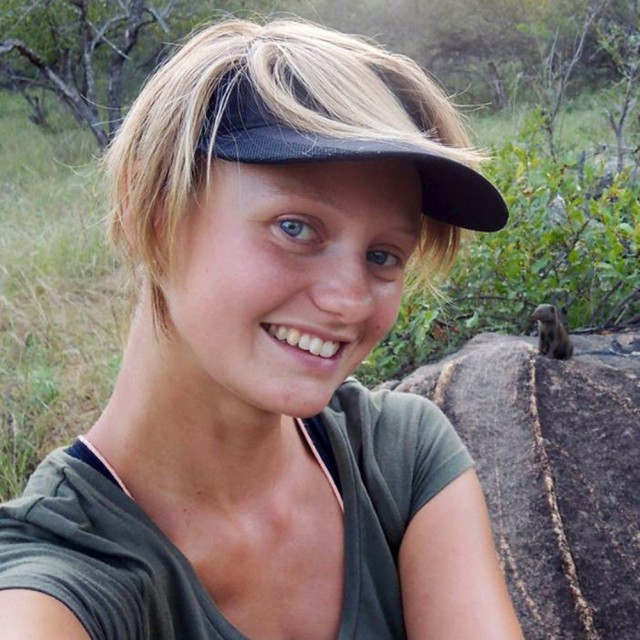

Amy has gained an in-depth understanding of dwarf mongoose behaviour by observing these quirky, charismatic creatures for hours on end. Here she shares her experiences!


Name: Amy Morris-Drake
Species: Dwarf Mongoose
Location: South Africa
Twitter: @Dwarf_Mongoose
Amy has an undergraduate degree in Biological Sciences, and is currently completing her Masters research project on Dwarf Mongoose.
Hi Amy, can you tell us a little about your research background?
Having always been fascinated by the natural world, it was no great surprise that I went on to study Biological Sciences at university. With the end of third year approaching, I knew that I wanted to continue working in this area, preferably with wildlife, but I didn’t have much of an idea what my next route would be. When an advert came up for a field assistant position on the Dwarf Mongoose Project in South Africa, I jumped at the opportunity. Fast forward two years and I am currently writing up a research masters using the dwarf mongoose as my study species. If someone told me upon graduating that this would be the case, I would have struggled to even describe what a dwarf mongoose looked like!
For those of us who still don’t know what a dwarf mongoose looks like, can you tell us a little about them?!
The dwarf mongoose is often described as Africa’s smallest carnivore, weighing in at around 300g. They are cooperative breeders, living in cohesive family groups of up to 30 individuals, consisting of a dominant male and female and several subordinate helpers who assist the dominant pair in raising their offspring. Highly charismatic up close, they are often seen as a small brown blur darting through their well-defended territories. Although the species is not endangered, the research myself and other team members have been conducting incorporates a conservation angle – investigating the impacts of noise pollution on the anti-predator behaviour of dwarf mongooses.
What issues are dwarf mongoose currently facing?
Man made noise is now recognised as a pollutant of international concern. In terrestrial environments, growth in transportation networks, resource extraction and urban development is responsible for chronic noise exposure. With a changing acoustic landscape, policies are being developed to protect human health and research into how noise pollution threatens wildlife is burgeoning.
The habituated dwarf mongoose population we work with inhabit an area bordering a busy tar road. By concentrating on their anti-predator behaviour, such as their sentinel system, alarm call vocalisations and their responses to direct predatory cues (faeces, urine etc.), we can study the direct fitness costs associated with living in a noisy area.
What is daily life on the Dwarf Mongoose Project like?
The Dwarf Mongoose Project is based on Sorabi Rock Lodge, a private game reserve near Kruger National Park in South Africa. The research house straddles two granite kopjes, one of which comprises the main refuge for a large troop of chacma baboons. Our morning alarm clock has three settings; Vervet Monkey, Tree Squirrel and Dassie! All frequent visitors to the grounds, and not shy in coming forward when it comes to making a racket. Being only a 40-minute drive from Hoedspruit, the nearest town, the research house is very well equipped in comparison to more isolated field stations.
The leopard is the only member of Africa’s infamous Big 5 found on the reserve. It being largely nocturnal means we are able to work on foot, following the mongooses in their natural environment, allowing us to gain a unique perspective into dwarf mongoose life.
On the commute to work it is always a treat to come across some of the reserve’s other resident species, such as giraffe, waterbuck, crocodiles and zebra, as well as checking for any fresh tracks from Sorabi’s nocturnal habitants, such as hyena, leopard, porcupine and aardvark.
During the summer months, when the sun rises early in the morning, we follow a group until they decide to rest in the midday heat. As well as collecting important project data, the morning session is the best time for conducting experiments, weather conditions permitting!
After putting our feet up and getting some lunch, it’s back out for the afternoon session. This involves re-finding the group, continuing with data-collection and following the group to a sleeping burrow in order to know where they are the following day. Over the winter months, with milder temperatures, the groups are on the move, foraging all day, translating into roughly 10 hours in the field. During this time we eat our lunch in the field. Coffee, snacks and a good book come in handy on windy days when the mongooses decide to have a lie in!
Tell us about the study population?
There are currently 7 habituated mongoose groups that we follow and collect an array of long-term data on, from group composition and life history events to latrine, sentinel and snake mobbing behaviours. All individuals within a group are identifiable by natural markings or small blonde dye marks on their fur. The dye is applied using an elongated paintbrush. Achieving good markings is definitely a case of practice makes perfect, due to mongooses’ skittish, yet inquisitive nature!
An important part of project data collection and keeping up individual habituation are the weights sessions, where the mongooses jump onto an electronic scale in exchange for a small eggy reward. Carried out at the mound before the group leave to forage, then again around midday and just before settling down for the evening, this data allows fluctuations in weights to be monitored, as well as any pregnancies.
What are the highlights of your project?
One of the main highlights is being able to gain an in-depth understanding of dwarf mongoose behaviour. By observing these quirky, charismatic creatures for hours on end you are treated to insights that under different circumstances you may not see. For example, a group coming together to mob a puff adder, a litter of pups emerging for the first time, or two rival groups fighting over territorial boundaries. Inevitably you also start to pick up on individual and group characteristics, such as who is the most adventurous, who each others allies are, and the group’s favourite sleeping burrow.
Another highlight is being able to work outside, on foot, in the African bush. From this perspective, you can appreciate the smaller species going about their every day life, as well as taking in all the different sounds and smells of the lowveld biome. With a plethora of wildlife there is always something fascinating to watch (aside from the mongooses of course), be it a dung beetle, hornbill, or a fork-tailed drongo, all foraging alongside the mongooses. Coming face to face with a somewhat startled honey badger was a particular highlight.
Working on a small, well-established project has been hugely rewarding. Julie Kern set up the project in 2011 for her masters research and is currently writing up a PhD on the species. The project has now seen 18 field assistants pass through, some of whom have subsequently returned, including me. It is a magical spot and a great place to start getting to grips with the trials and tribulations of fieldwork in the African bush.
Are there any challenges?
Working with wild animals is always going to be a challenge! Especially when you have a limited amount of time to get a certain number of experiments done. Searching for a group that hasn’t been observed in a couple of days can sometimes turn into a bit of a wild goose chase (excuse the pun). This is amplified during the summer months, when the vegetation is more abundant after the rains. In these instances you are less reliant on sight to locate to mongooses, and more on sound, tuning in to specific vocalisations they make for communication.
The main thing I’ve learnt is that things take a lot longer than initially planned and you have to be able to accept that a lot of factors are totally out of your control. Sometimes the mongooses don’t want to cooperate with experimental procedures. On other occasions it’s too windy or a passing raptor has sent them into an alarm call frenzy. Patience is key!
During the summer months, the invertebrate and reptile community also make an appearance. Walking into large spider webs is a daily occurrence and gaiters become a mandatory addition to the bush wardrobe if you don’t want to be plucking ticks from your ankles all day! Thankfully the mongooses usually come across snakes before we do and give out a handy ‘snake mob’ call to warn the rest of the group. It does pay to be cautious though. I very nearly stepped on a sluggish puff adder when out searching for a mongoose group. Luckily it spotted me first and let out a distinctive hissing sound…
Lastly, what are the top five things you wish you had known before you started your fieldwork?
1. Things take a lot longer than originally planned! Adapt schedules accordingly.
2. Experimental plans and procedures will change. Keep cool, it’s the nature of fieldwork and not worth manically stressing over.
3. Gaiters will be your new best friend. Tick bites are a nuisance and although not 100% effective these field essentials certainly do help.
4. Knowing the ins and outs of project vehicles is very useful. Particularly how to change a tyre, as sods law this will happen when you least expect it, in the middle of nowhere. Vehicles take a battering travelling through this rocky terrain and a bit of TLC is necessary if you want to get anywhere on ‘African’ time.
5. Smelly eggy fingers will become a daily norm. The mongooses are accustomed to receiving small bits of egg as a reward for jumping into the weights box. There is definitely an art to good egg flicking; without making any large ‘scary’ gestures, each mongoose should be tempted onto the scales, whilst other egg fanatic group members are distracted.
Thanks Amy!